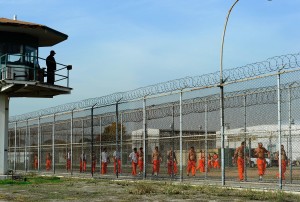What happens when you take 2,600 of the most violent people in the state and cram them in housing meant for 1,800?

That question is surfacing in the wake of a riot among more than 50 prisoners at California State Prison, Sacramento on Wednesday that sent 13 prisoners to the hospital, one of them shot by a guard.
The prison is at 145 percent of capacity. While the state has been reducing its prison population by sending some inmates to local jails, overcrowding persists. The Department of Corrections has not said whether this problem played a role in Wednesday's melée at the institution known as “New Folsom.” But it fits a pattern of incidents over the past year:
- On September 15, 2012, a prisoner died after being stabbed at Salinas Valley State Prison in Soledad.
- On March 6, 2012, guards at the older Folsom State Prison suppressed a riot of about 70 suspected gang members using pepper spray and nonlethal rounds, according to the Sacramento Bee.
- On December 7, 2011, about 150 prisoners rioted at New Folsom, and 11 went to the hospital, also including one shot by officers.
- On May 20, 2011, another riot at New Folsom sent six inmates to the hospital, two with serious injuries.
To get an idea of what’s behind this violence, The California Report's Rachael Myrow interviewed Michael Montgomery, who covers the state’s prison system for KQED and California Watch. Here are some excerpts from their conversation:
Michael Montgomery: This is a high-security prison. It’s where the most dangerous inmates are held, many of whom are convicted of violent offenses. These types of incidents are not uncommon. The department is nervous, and I am hearing at least anecdotally about a possible spike in violence. The fact that an officer used a firearm means it was very serious. They only do that when a life is threatened. Sources I talked to last night say there may have been gang involvement, but the Department of Corrections says they are still investigating.